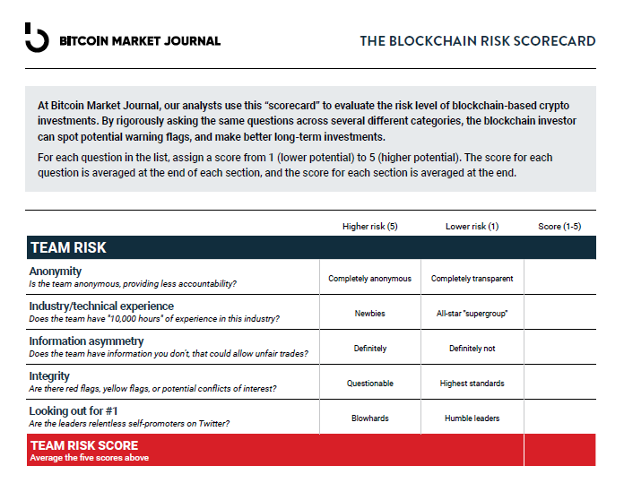
Summary: Our new downloadable PDF for spotting risky crypto projects, before you invest. Subscribe here and follow me to get more crypto investing tips and tricks.
Investing comes with risk. Crypto investing, doubly so.
- The risk of inexperienced teams running the crypto project.
- The risk of the project running out of money.
- The risk of regulators suing the project.
- The risk of a flaw in the smart contracts.
- The risk of nobody using it.
I recently asked for your help in thinking about the risks you’ve seen or experienced as crypto investors.
Boy, did the Bitcoin Market Journal community deliver.
We rolled up all your terrific suggestions into our new Risk Scorecard, a PDF that you can download here:
This little scorecard could save you millions of dollars.
How the Scorecard Works
Like our Blockchain Investor Scorecard, we’ve broken up risk into six categories – Team Risk, Financial Risk, Regulatory Risk, Smart Contract Risk, Traction Risk, and Behavioral Risk – with a few simple questions on each.
Before you invest in a crypto project, you can do your research to give each question a 1- to 5-star token, with 1 being lowest risk and 5 being highest risk.
Then you average up the questions, average up the sections, and end up with a total risk score.
Some of the questions are easy to answer (“Is the founding team anonymous?”), while some will require digging (“Do they have enough operating cash on hand?”). If you can’t find the answer, you can skip those questions.
And if all this is too much work, you can sign up for our Premium membership, where our analysts will use this risk framework to score the top tokens.

How You Made It Better
Here are the six sections, along with community comments that improved our thinking.
The Team Risk section digs into the founding team. Do you know who’s behind it, or do they hide behind anonymity? Do they have a track record of success? Do they have information you don’t?
“We should definitely highlight the failed businesses and tantrums of the leadership teams.” (See “Looking Out for #1.”)
The Financial Risk section looks at the money. Are they well-capitalized? Well-diversified? Do they warn about risks, or do they promise ever-increasing returns?
“You might also include if there are large dependencies on single asset holdings or leverage. LUNA comes to mind.” (See “Eggs in One Basket.”)
The Regulatory Risk section analyzes the probability of being sued by the SEC or similar authorities. All crypto entails some risk of this kind, more if they are a category leader or based in a country with unclear regulation (like the U.S.).
“The SEC offers their own risk framework for investors. For the right questions to ask, you might start there.” (It’s a good start, but it’s not really targeted to crypto. We hope the SEC will follow our lead – our new scorecard is better.)
The Smart Contract Risk section looks at the underlying code. Most investors can’t perform a full technical audit; we just need assurance that someone has. Projects that are stress-tested are less risky than new and unproven ones.
“While many of the questions are prudent, the largest challenge any noob faces is where to find said information. Readers would benefit from some resources and guidance for where to do their own due diligence.” (Great point, see below.)
Traction Risk analyzes the number of users and partners. Well-used crypto projects tend to be more accountable (think about how Ethereum handled The DAO hack), whereas smaller projects could leave you holding the bag.
“There is no magic formula. We’ve been asking these questions of our startup portfolio companies for years.” (True: Terra would have easily passed this section. But it would have failed at others.)
Finally, the Behavioral Risk section looks at your own motivation for investing.
“You should really just call this greed. Even FOMO is another form of greed.” (Based on this feedback, we called this your personal “Greed Index,” reminding investors that motives matter.)
Where to Find this Information
The Blockchain Risk Scorecard is a great tool, but where do you find this information? Here are the resources our analysts use:
- Team Risk section: Visit the official project website, look for the team members, and research them on LinkedIn. If you can’t find them, run away.
- Financial Risk section: Visit the official project website; dig into the white paper; read news stories from reputable sources; join the project’s Discord and ask around.
- Regulatory Risk section: These are judgment calls based on how investors talk about the project on Twitter, Reddit, or Discord.
- Smart Contract Risk section: Check the project’s GitHub.
- Traction Risk section: Use tools like IntoTheBlock, Token Terminal, or Glassnode.
- Behavioral Risk section: Use your conscience as a guide.
Of course, filling out this scorecard takes work, but good investing always does.
The shortcut is to sign up for our Premium subscription, where we’ll be using this Risk Scorecard for the most popular crypto investments in the weeks ahead.
Risk and reward go hand-in-hand. Now, the industry has a way to measure each.


